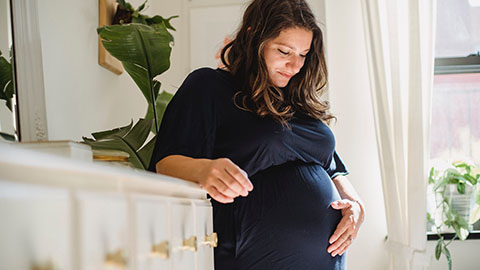
A pregnant client has pain and numbness in her hands. It is NOT what you think. In this conversation with pregnancy massage expert Carole Osborne, we take a look at a common pregnancy-related complaint, and see how it can offer some surprises!
Carole is a board-certified therapeutic massage and bodywork practitioner, an educator, and a practice supervisor/mentor. She is the co-author of Pre- and Perinatal Massage Therapy 3ed, and she has developed an internationally known course of the same name, as well as other continuing education courses. She was the 2008 AMTA National Teacher of the Year. Since beginning her career in 1974, she has worked in her own private practice and in osteopathic, psychological, and women’s medical settings. Her work focuses on facilitating somato-emotional and neuromuscular integration, particularly related to childbearing, trauma, substance and eating disorders, self-image, and nurturing. For more about her and her work, visit www.bodytherapyeducation.com.
Resources:
Body Therapy Education—Learning Developed by Carole Osborne: www.bodytherapyeducation.com
Carole Osborne, Michele Kolakowski, and David M. Lobenstine, Pre-and Perinatal Massage Therapy: A comprehensive guide to prenatal, labor and postpartum practice (Scotland: Handspring Publishing Limited, 2021), www.handspringpublishing.com/product/pre-and-perinatal-massage-third-edition



This podcast sponsored by:
About Anatomy Trains:
Anatomy Trains is a global leader in online anatomy education and also provides in-classroom certification programs forstructuralintegration in the US, Canada, Australia, Europe, Japan, and China, as well as fresh-tissue cadaverdissectionlabs and weekend courses. The work of Anatomy Trains originated with founder Tom Myers, who mapped the human body into 13 myofascial meridians in his original book, currently in itsfourthedition and translated into 12 languages. The principles of Anatomy Trains are used by osteopaths,physicaltherapists,bodyworkers,massagetherapists,personaltrainers,yoga,Pilates,Gyrotonics,and other body-minded manual therapists and movement professionals. Anatomy Trains inspires these practitioners to work with holistic anatomy in treating system-wide patterns to provide improved client outcomes in terms of structure and function.
Website:anatomytrains.com
Email:info@anatomytrains.com
Facebook:facebook.com/AnatomyTrains
Instagram: instagram.com/anatomytrainsofficial
0:00:00.0 Speaker 1: Ruth Werner's best-selling book, A Massage Therapist's Guide to Pathology, is a highly regarded, comprehensive resource that sets the standard for pathology education. Written for massage therapy students and practitioners, this ground-breaking resource serves up a comprehensive review of the pathophysiology, signs, symptoms, and treatment of more than 500 diseases and disorders. Learn more at booksofdiscovery.com.
0:00:32.0 Speaker 2: Anatomy Trains is happy to announce our return to the dissection lab in person, January 10, to the 14th, 2022 at the Laboratory of Anatomical Enlightenment in Boulder, Colorado. We are thrilled to be back in the lab with Anatomy Trains author Tom Myers and master dissector, Todd Garcia. Join students from around the world, and from all types of manual, movement, and fitness professions, to explore the real human form, not the images you get from books. This is an exclusive invitation, email: Info@AnatomyTrains.com if you'd like to join us in the lab.
[music]
0:01:16.8 Ruth Werner: Hi, and welcome to I Have a Client Who... Pathology conversations with Ruth Werner. The podcast where I will discuss your real life stories about clients with conditions that are perplexing or confusing. I'm Ruth Warner, author of A Massage Therapist's Guide to Pathology, and I have spent decades, studying, writing about and teaching about where massage therapy intersects with diseases and conditions that might limit our client's health. We almost always have something good to offer even with our most challenged clients, but we need to figure out a way to do that safely, effectively, and within our scope of practice.
0:01:57.6 RW: And sometimes, as we have all learned, that is harder than it looks. Today's 'I have a client who' story comes to us from our field's go-to resource for anything about pathology in the context of pregnancy and the perinatal year. I am really happy to invite a guest with us today, Carol Osborne, who is the author of Pre‑ and Perinatal Massage Therapy, just out in its third edition from Handspring, and Carol also teaches classes in perinatal massage and massage for the pregnancy year, among other things. Carol, welcome, I'm so happy to have you here.
0:02:38.8 Speaker Carol Osborne: No, I'm so delighted to be here too. We get to play together.
[laughter]
0:02:45.8 RW: I invited Carol because we were having a chat about a fairly common 'I have a client who' story that comes up with pregnants who are clients, and so... Pregnants who are clients... Very good. With clients who are pregnant. So Carol, why don't you tell us a little bit about your 'I have a client who' story.
0:03:04.4 CO: Alright. So this is a massage therapist who came to me. She was having her first baby, and she came in around her 30th week of her pregnancy when she was beginning to have hand pain increasing. It had been before, but now it was starting to increase. Prior to that pregnancy, she had had some tendinitis in her hand that had resolved itself, and so that was done with before she was pregnant. This time, she was having whole hand numbness and pain, lots of numbness.
0:03:52.5 RW: And was it just on the one side or was it bilateral?
0:03:56.5 CO: It started out on one side and then it quickly went to both sides. And it started out with a little bit of tingling, and then became numbness. And...
0:04:11.6 RW: That's serious.
0:04:13.3 CO: Yeah, yeah. And of course, it was worse when she had a long client day, and then it would subside a little bit, but despite doing things like elevating her hands and splint in... Elevating when she was sleeping and stuff, it really wasn't getting better. So she came to me, she had been putting off coming to get some prenatal work because she just was feeling so good, and it just didn't seem like she needed to do that and then... You know how that goes.
[laughter]
0:04:54.2 CO: Now she was... [laughter]
0:04:54.9 RW: Massage therapists are so good at the self-care.
0:04:58.3 CO: Yeah, right, right.
0:05:00.9 RW: So, I'm just gonna... I'm gonna interrupt for a moment, Carol, and ask listeners to think about what they think might be going on here, 'cause I have some ideas about what's happening, and I'll share them. Because as pregnant people get further and further along in their process, and we're at 30 weeks you said? So she's pretty close, she's six weeks out.
0:05:23.9 CO: Six to eight weeks out, yeah.
0:05:25.9 RW: Okay.
0:05:26.4 CO: Yeah.
0:05:27.4 RW: You know, and we start retaining water, and it's pretty common for pregnant ladies to experience some level of carpal tunnel syndrome just from the excess fluid pressure in the extremities, and that typically resolves after the pregnancy is over. And given her occupation, and what she's doing with her hands, and she's still working at 30 weeks... That's a big ask of this body. So, was it carpal tunnel syndrome?
0:05:55.2 CO: Well, No. It wasn't carpal tunnel syndrome. [laughter]
0:06:02.1 RW: Was it pre-eclampsia? 'Cause that can cause big swelling too.
0:06:05.3 CO: It can indeed. And that was one of the most important parts of my critical thinking process there, was to look for some signs of whether she was having any preeclampsia, to look for systemic edema, to look for pitting edema to look for whether her hands, was she still wearing her wedding ring or not, that sort of thing, and she had none of those symptoms.
0:06:34.7 RW: Good.
0:06:35.6 CO: Yeah, so there was none of that, and also I checked about whether... What were her lab, her urine test showing with her doctor. And no protein in the urine. So again, we had that.
0:06:50.4 RW: Can rule out some worst case scenarios that way.
0:06:53.5 CO: Exactly, exactly. And also, what rules it out for me was also the fact that she was having bilateral pain and numbness, and the numbness being her worst symptom to me, and that it was her whole hand. It wasn't the innovation of median nerve.
0:07:18.9 RW: So it wasnt just the thumb, fore finger, and half the middle finger, it was the whole.
0:07:24.9 CO: Right it was the whole hand.
0:07:26.3 RW: That's weird.
0:07:27.0 CO: Right? Right. Well, no, actually it's not all that weird to me because I see that. I see hints of that. And I see that pretty frequently. And depending on what people do for spend their times doing. She actually had thoracic outlet syndrome is what she had, and it was pretty easily confirmed by the work that I did with her about what brought her some relief.
0:08:04.8 RW: Yeah. Alright, so she had thoracic outlet. It's easy to see, although I will ask you about whether that might be pregnancy-related, but she developed it bilaterally, which makes me think probably that was pregnancy-related because typically we wouldn't think about the thoracic outlet on both sides.
0:08:23.4 CO: Yes.
0:08:24.1 RW: That's not a typical presentation.
0:08:26.0 CO: Yes, yeah, and that's the thing in pregnancy though what's happening oftentimes is the combination of the relaxant creating this fluidity and openness and stretch in the ligament structures, you've got the extra anterior weight load of not only the baby, but also enlarged breasts.
0:08:51.8 RW: I was gonna say that's why we're gonna get top-heavy as well as bottom heavy.
0:08:55.2 CO: Yes, and so the resulting forward rotation of the shoulder girdle begins putting some pressure there, and it's usually both sides. It's not one side or the other, it's both sides.
0:09:08.4 RW: Of course, yeah, that makes lots of sense.
0:09:10.9 CO: And then, so she's at 30 weeks, so now we've got a fundus of a uterus that's pretty high up near that, not quite in her throat, but it can feel that way, especially if she doesn't have a lot of integration in her structure and integrity in her structure, so she was a kind of collapsed pregnant... She had a pretty collapsed pregnant body.
0:09:41.9 RW: Well if you think about working at a massage table, that's a turned in posture as well.
0:09:47.6 CO: And then you add that on top of it, right? That she's spending so many hours in a forward rotation on her shoulder girdle anterior rotation there. And then, of course, one of the first things I paid attention to too was her breathing, and she was in that shallow later pregnancy kind of chest breathing, trying to... Knowing in her head that she needed to be breathing deeper, but having some difficulty in how to accomplish that with this baby's butt right there.
0:10:28.3 RW: Pushing up on the top of her diaphragm, yeah.
0:10:30.6 CO: Exactly exactly.
0:10:32.8 RW: And that's gonna activate scalenes and the first rib is gonna come way up and all that, right? Wow.
0:10:40.7 CO: Exactly, exactly. Yeah, yeah. So the main thing I focused on was what I could do to lengthen out the shortened places in her fascia and her muscles to help her to get some more expansional balance.
0:11:01.8 RW: A little more space.
0:11:03.5 CO: To help her to go up better into the upper pole and to sink further down through the bottom pole, so that meant putting a good bit of attention to loosening and mobilizing through pec major, pec minor, teres major even, getting the whole pectoral girdle to be able to play more in a posterior rotation and to emphasize that. And to ask her to spend some time really activating those posterior muscles, which would strengthen them as well as stretch across here. And then, of course, the other part of it is in order to be able to relieve that, her low back and the integrity of her alignment of her pelvis and releasing the quadriceps because they're really tight when the... When the pelvis is tilted. And working to lengthen the lumbodorsal fascia and releasing the quadratus lumborum, so that it's letting the pelvis have some space. And then the other big part of it was working with her breathing.
0:12:30.8 CO: And it's a simple but yet very complex thing to do education with a client that will bring breathing into the lateral rib cage and the posterior rib cage. And when you're pregnant, that's all the real estate you got left. So if you don't move in there, you're gonna stay in the crowded area of the city. Well, did it correct the problem? Here's the thing about pregnancy. I consider that we've had successful work if at whatever stage the person comes in with their complaint, that it doesn't worsen as they go through the pregnancy, because...
0:13:19.2 RW: That sounds like a good success.
0:13:21.0 CO: That is at least a measure of success. And if it turns out that you and they, working together, can get a reduction of a pain, wow, that's exceptional. And to get it to go away...
0:13:41.7 RW: Especially that late.
0:13:44.1 CO: Exactly, that late. And that's why I really, really encourage knowledgeable therapists to be working with pregnant clients early in their pregnancies.
0:14:00.8 RW: Well, that's a terrific story, and I'm going to assume that she came out okay, and everybody's happy and healthy?
0:14:07.6 CO: Yeah, absolutely, absolutely. And she had the typical thing that happens though with many pregnant people is that the postpartum time is a very difficult challenge on the pectoral girdle. And so the problem did indeed persist for a while postpartum. And what... Oh, yeah, yeah, and actually...
0:14:38.5 RW: Yeah, so not an instant fix?
0:14:40.4 CO: No, it's not. And also, actually, the research on both carpal tunnel and thoracic outlet in pregnancy is that it's actually more common postpartum.
0:14:54.4 RW: Really?
0:14:55.3 CO: Yeah, yeah.
0:14:56.2 RW: Fascinating.
0:14:57.6 CO: Yeah, interesting. Yeah, it is. And of course, if you think about how much of the child caring activities are this forward rotation and static weight...
0:15:11.1 RW: And carrying car seats.
0:15:12.6 CO: Oh, goodness. And the many ways in which to hold a bottle or to hold your breast in the right angle, and once you've got that baby latched, you don't wanna move no matter what. But no telling what it's doing on your wrist and your hands. So it is pretty common. She did wind up, though, further along in the three to six month time frame. It was pretty much resolved for her. And one other great thing, of course, she's body worker, so she has her intention to better her body all the time. One of the things she really appreciated about the pregnancy and having this happen was that it motivated her to take care of some weakness in her back that she was ignoring. And it motivated her to do that, so that actually did help her in her work further on.
0:16:31.2 RW: Yeah, it was a long-term consequences. That's great. Well, Carol, thank you so much for sharing that terrific 'I have a client who story.' And I wish you a very Happy Mother's Day.
0:16:45.1 CO: And thank you to you too, Mother Ruth.
0:16:48.6 RW: Thank you very much.
0:16:50.6 CO: And to everyone else who has had the joy and the challenge of mothering.
0:16:57.7 RW: Yes. And also, just to let you know, I will have links in the show notes today about how to get in touch with Carol if you would like to do some work with her, and of course, how to get her book.
0:17:09.2 RW: Hey everybody, thanks for listening to, I Have a Client Who... Pathology conversations with Ruth Werner. Remember, you can send me your I Have a Client Who stories to ihaveaclientwho@abmp.com. That's, I have a client who, all one word, all lowercase, @abmp.com. I can't wait to see what you send me, and I'll see you next time.